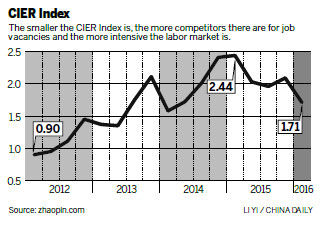1st quarter job market stays stable
Updated: 2016-04-23 07:42
By Su Zhou(China Daily)
|
|||||||||
Despites lowing economy and restructuring, unemployment rate remained relatively low
The overall employment situation in China during the first quarter was stable, despite downward pressure on the economy.
The nation's registered unemployment rate in urban areas stood at 4.04 percent at the end of March, down from 4.05 percent at the end of 2015, according to the Ministry of Human Resources and Social Security.
An additional 3.18 million urban jobs were created in the first three months of 2016, said ministry spokesman Li Zhong at a news conference on Friday.
"According to our investigation of the situation in 100 cities, job vacancies still outnumber job seekers," said Li, who added that there are an estimated 100 job seekers for every 107 positions.
The new jobs created have canceled out job losses brought about by the slowing economy and the restructuring of the manufacturing sector.
"The data indicates that China's job market remains stable," Li said, attributing the increase in the number of jobs and the low unemployment rate mainly to "slow but reasonable economic growth, the government's deepened reform and innovation drive, and pro-employment policies".
China's economy continued to slow in the first quarter, with GDP growing 6.7 percent year-on-year to reach 15.9 trillion yuan ($2.45 trillion). But the figure was in line with market expectations and remained within the government's targeted range of between 6.5 and 7 percent for 2016.
However, when compared with last quarter, the labor market is grim, with fewer vacancies and a smaller number of jobs created.
According to the Chinese job recruitment website Zhaopin and the China Institute for Employment Research, the CIER index has decreased from last quarter's 2.09 to 1.71. The index was developed to monitor the trends of the labor market. It equals the number of job vacancies divided by the number of job seekers.
Zeng Xiangquan, dean of the School of Labor and Human Resources at Renmin University of China, said there are still unpredictable factors in the domestic macroeconomic situation.
He said the job market was still in a weak recovery state due to deflationary pressure and the doldrums of the real economy. "The producer price index continued to decline, discouraging manufacturing production and decreasing demand for labor. The continuous advancement of industrial upgrading has presented a challenge to our country's labor structure,"Zeng said.
Xinhua contributed to this story.
Capacity cuts shrinking workforce
The demand for workers in central and western parts of China fell during the first quarter of the year in the wake of those regions taking steps to reduce excess industrial capacity in the labor-intensive energy and manufacturing industries.
According to a report about the job market jointly released by the Chinese human resources website Zhaopin and the China Institute for Employment Research on Thursday, the demand for labor in the western region dropped 3 percent in comparison to the same period last year. The region includes Shaanxi province and the Inner Mongolia and Xinjiang Uygur autonomous regions.
Meanwhile, the central region saw a tiny, 1 percent growth in demand for labor.
The eastern region had a better time, seeing a 5 percent growth in the demand for workers, despite the slowing economy.
The report said the task of reducing excess industrial capacity is a top priority in many provinces. The restructuring has squeezed the profit margins of related industries in addition to influencing the job market.
China's economy is expected to face extra pressure as additional excessive industrial capacity is shed, especially in the steel and coal sectors.
The moves are in response to the Chinese government's vow to deal with excess capacity and eliminate hundreds of so-called zombie enterprises - loss-making firms in struggling sectors. An estimated 1.8 million workers are expected to be laid off in the coal and steel sectors.

Today's Top News
Chinese philanthropists explore British way of 'giving'
Back on the up
China leads way on US adoptions
Ericsson reshapes and sees Q1 profit rising
Snowden sues Norway to seek safe travel to get prize
Nation's drones are in demand
Beacons and gun salutes as Queen turns 90
Buckingham Palace seeks royal social media operators
Hot Topics
Lunar probe , China growth forecasts, Emission rules get tougher, China seen through 'colored lens', International board,
Editor's Picks

|

|

|

|

|

|







